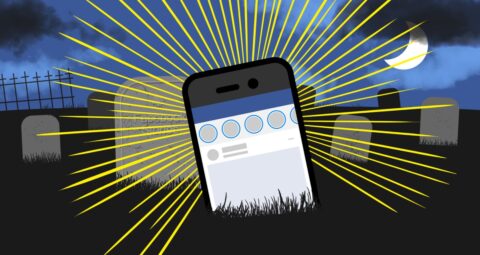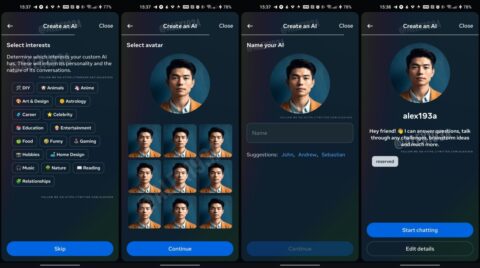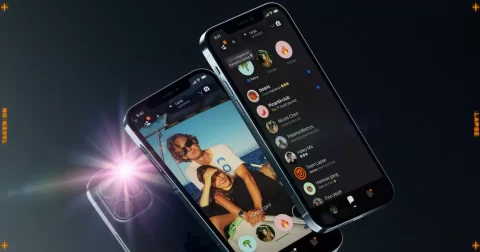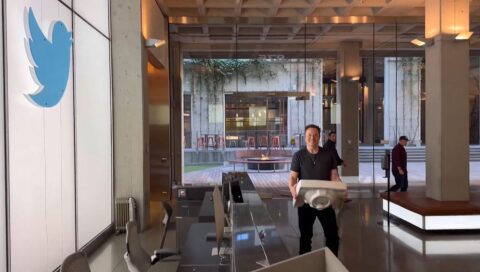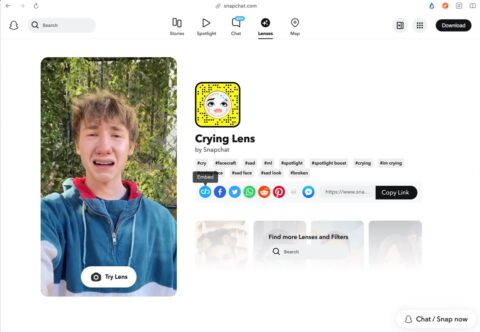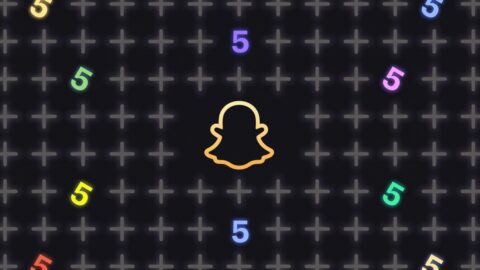Meta is introducing a new API that makes it easier to create and share a Facebook Story directly from a third-party desktop or web app. The social networking […]
Instagram spotted developing a customizable ‘AI friend’
Instagram has been spotted developing an “AI friend” feature that users would be able to customize to their liking and then converse with, according to screenshots shared by […]
Photo-sharing app Lapse appeals to users who want a more personal social media experience
Lapse, a photo-sharing app with a film filter, shot to the top of the App Store thanks to a clever gimmick. But can its users get hooked on yet another social media app?

It’s a truth universally acknowledged that social media sucks right now.
Platforms are overrun by ads and sponsored posts, and algorithms don’t prioritize the social aspect of digital connection. The swift rise and fall of BeReal, an app that offered a solution to the disappointing state of the social media landscape, now seems more like a cautionary tale. That’s not stopping developers from trying to revolutionize the way we connect online, and Lapse is the latest alternative social media app on the scene.
It advertises itself as “the invite-only disposable camera.” On Lapse, you take a photo (called a “snap”) and send it to the “darkroom” to be “developed.” At an unspecified time later in the day, you’ll get a notification that your photo is ready, and you can see the photo you took transformed by Lapse’s grainy, analog filter. Once you see the photo, you can decide whether to post it in your gallery or archive it.
Lapse forgoes an algorithmic feed and aims for something more personal and chronological. Snaps live on your profile, or your “Journal,” which can be customized with music, a carousel of select images, your zodiac sign, and emojis. Meanwhile, your friends can react to your snaps, or share a “vibe,” with a range of pre-selected randomized emojis.

Credit: Lapse: @crystalbbell
The photo app remixes aspects of other platforms to create a unique, yet familiar experience. It incorporates the camera roll archive of Snapchat, the film-like filter of Dispo, the photo-sharing element of Instagram, and the low-stakes, low-key nature of BeReal.
The darkroom gimmick of Lapse encourages users to live in the moment and take a photo and go, contrary to the fraught Instagram experience of taking dozens of photos and immediately scrutinizing them for posting potential or the instant gratification of BeReal.
“With Instagram now, I feel like you have to think long and hard about what’s going to be on your feed, but if I want to take a picture of the fucking chicken fingers that I made, then I can post it on Lapse,” Daniel Head, a 32-year-old Lapse user in Brooklyn, New York, told Mashable.
Lapse isn’t new — it first launched in 2021 as a collaborative disposable camera roll app — but in June, it rebranded to more of a traditional social media platform with profiles where users could share their “developed” photos and organize them into monthly “memories” and albums. At its launch, Lapse raised $11 million in seed round funding.

Credit: Lapse
In the last month, you’ve likely received a cryptic text message from a friend along the lines of “we need this,” accompanied by an early access invite to Lapse. The platform requires new users to invite five or eight friends via text message before they can start using it. At the end of September, it shot up from No. 118 to No. 1 in the App Store — it currently sits at No. 2 — as a result of this growth hack. According to data.ai, Lapse had nearly 1.2 million users worldwide in late September.
Joshua Santos, a 27-year-old software engineer in Phoenix, Arizona, started using Lapse at the beginning of October. “It felt off that I had to invite other people just so I could use the app,” Santos told Mashable. “It was like some weird pyramid scheme.”
The app co-founders Dan and Ben Silverton stand by their onboarding process. Dan told TechCrunch, “We are top of the charts because Lapse is resonating with young people, who are sharing millions of photos per day in our app. They are exhausted by existing photo-sharing apps, and Lapse is a way for them to live in the moment and share memories pressure-free.” It also clearly benefits from young people’s insatiable nostalgia for vintage tech following the disposable camera boom in 2019.
But texting friends isn’t the only requirement to access Lapse. “You have to add the [Lapse] widget to your home screen or your lock screen, which is kind of wild. Like, oh, OK, we’re really being invasive with it,” explained Head.
Other users, like Ria Bhagwat, don’t mind the widget. “[The widget] is very engaging. It convinced me to want to use it more,” the 23-year-old freelance journalist told Mashable.
The platform successfully gamed the system for downloads, but can its users get hooked on yet another social media app? BeReal taught us about how quickly the novelty of a new social platform can wane, and while Lapse is breaking through without the incentive to use it daily, its staying power remains unclear.
But so far, Bhagwat is hooked. She posts on Lapse two to three times a day to 50 friends. “I am not usually a fan of photo apps. I had Snapchat in college. It forced me to always be on high alert about how I looked or what I was doing,” explained Bhagwat. “Lapse is nice because a lot of people use it for scenery. It’s different from Snapchat or BeReal because it’s not focused on the person who is posting, it’s more what they’re doing or who they’re with.”
Another draw of the app is that at the end of each month, all your posts are consolidated into an album. Jasmine, a 29-year-old art director in Brooklyn, treats it like a photo diary.
She also appreciates the community she’s built on the app. “I was looking at Lapse this morning, and it was nice to have people that I recognize and talk to in real life on it,” she explained to Mashable. “I open it and then scroll for 10 seconds and put it away. It doesn’t feel like a black hole.”
One year after Musk acquired Twitter: Traffic, revenue down across the board
X’s traffic, revenue, and users are way down a year after Elon Musk’s take over. Has Musk let that sink in?

It’s Oct. 27, 2023: Exactly one year after Elon Musk took over Twitter.
Much has changed. For one, the platform isn’t even called Twitter anymore. Musk changed the name to “X.” Mashable’s Chris Taylor just published a piece looking at some of Musk’s biggest decisions that altered the course of the company.
In this piece, however, we’re going to focus strictly on numbers and the astounding effects of Musk’s decisions – and it’s not looking too good.
The most striking of X’s plunging metrics is its daily active user count, a figure that the company has historically focused on to signal growth. In November 2022, around a month after his acquisition, Musk boasted that the platform was growing from more than 254 million daily active users before his takeover to nearly 260 million a month later.
However, during an interview at a tech conference last month, X CEO Linda Yaccarino shared that the platform currently has 245 million daily active users per month, a loss of roughly 3.7 percent.
New data from X paints a bleak picture
In a series of slides that Musk posted last November, he promoted other platform metrics like “new user sign-ups” and “active minutes.” According to the slide, the platform, then still known as Twitter, was pulling in an average of two million new user sign-ups per day. In addition, Musk claimed then that users spend eight billion active minutes on the platform.
However, in a new blog post from Yaccarino commemorating the one year anniversary of Musk’s take over, the company’s data shows drops in those metrics too. According to the post, new daily sign ups are at 1.5 million and active minutes spent on the platform has dropped to 7.8 billion. That’s a drop of 500,000 daily sign-ups and 200 million active minutes.
Using data from mobile analytics firm Sensor Tower, the Wall Street Journal also found that X is the only major social media platform to experience a loss in daily active mobile users over the past year. Usage has dropped by 16 percent over the past 11 months.
Furthermore, when it comes to X’s mobile apps, downloads are down, too. But the overall picture here is a much more interesting story. Musk’s takeover actually did provide a bump in downloads of X’s mobile app for three straight quarters when compared to before the acquisition. However, in the most recent quarter, which includes the period in which Musk changed the name from Twitter to X, mobile app downloads drastically decreased by 38 percent – the platform’s lowest app download numbers since 2019.
And it’s not just a mobile decline either. According to the web analytics firm SimilarWeb, traffic to X’s website is down by 14 percent when compared to last year.
Ad revenue isn’t looking good either
None of these numbers compare to the decline in X’s advertising revenue, however. Musk has struggled to keep advertisers around since the earliest days of his leadership. In his first weeks at the helm, half of the company’s biggest advertisers stopped running ads on the platform due to Musk’s content moderation decisions and his questionable antics. A report from Reuters earlier this month found that advertising revenue at Musk’s company declined every single month since the takeover. Over a 10 month period ending in August, Twitter’s overall revenue was down by a whopping 60 percent.
One metric where the company did grow was in X Premium subscribers. However, there’s more to that, which doesn’t paint such a rosy picture. When Elon Musk took over the platform, the subscription service, then known as Twitter Blue, wasn’t really a focus of the company. It was treated more like an experiment and had tens of thousands of paying users. Today, with Musk and company depending on X Premium to make-up for billions of dollars in lost ad revenue, third-party estimates say it’s pulling in nowhere near that.
In August, Mashable reported on data collected by Travis Brown, an independent researcher that tracks X Premium subscriptions, which found that there were just under one million subscribers. Today, it seems likely there are around 1 million X Premium subscribers in total paying the company $8 per month. But, those totals are far and away from the billions of dollars that X needed to make up from advertisers that left. Compared to Snapchat, a social media competitor who also launched its own paid subscription service last year around the same time as X, Musk’s platform isn’t looking so good. Snapchat recently announced it had signed up 5 million paying users for its subscription service in just around 12 months.
While things aren’t looking great for X, it’s still chugging along. For now. Musk paid $44 billion for the company and he overpaid by a lot. He’s also shared multiple times that the company has yet to become cash-flow positive. And investors are going to see some sort of return on investment at some point. How much longer can Musk’s X keep chugging along? We’ll probably soon find out.
Snapchat is now allowing websites to embed content
Snapchat has relied on people consuming content on its own app. But now, the social network is allowing websites to embed public content including Lenses, Spotlight videos, Public […]
Snapchat now has over 5 million paying users for Snapchat+
Snapchat announced today its subscription service for power users, Snapchat+ has now topped 5 million subscribers — a figure that’s up from 4 million in late June and […]
